Intel Core i7-10700 vs Core i7-10700K Review: Is 65W Comet Lake an Option?
by Dr. Ian Cutress on January 21, 2021 10:30 AM EST- Posted in
- CPUs
- Intel
- Core i7
- Z490
- 10th Gen Core
- Comet Lake
- i7-10700K
- i7-10700
CPU Tests: Rendering
Rendering tests, compared to others, are often a little more simple to digest and automate. All the tests put out some sort of score or time, usually in an obtainable way that makes it fairly easy to extract. These tests are some of the most strenuous in our list, due to the highly threaded nature of rendering and ray-tracing, and can draw a lot of power. If a system is not properly configured to deal with the thermal requirements of the processor, the rendering benchmarks is where it would show most easily as the frequency drops over a sustained period of time. Most benchmarks in this case are re-run several times, and the key to this is having an appropriate idle/wait time between benchmarks to allow for temperatures to normalize from the last test.
Blender 2.83 LTS: Link
One of the popular tools for rendering is Blender, with it being a public open source project that anyone in the animation industry can get involved in. This extends to conferences, use in films and VR, with a dedicated Blender Institute, and everything you might expect from a professional software package (except perhaps a professional grade support package). With it being open-source, studios can customize it in as many ways as they need to get the results they require. It ends up being a big optimization target for both Intel and AMD in this regard.
For benchmarking purposes, we fell back to one rendering a frame from a detailed project. Most reviews, as we have done in the past, focus on one of the classic Blender renders, known as BMW_27. It can take anywhere from a few minutes to almost an hour on a regular system. However now that Blender has moved onto a Long Term Support model (LTS) with the latest 2.83 release, we decided to go for something different.
We use this scene, called PartyTug at 6AM by Ian Hubert, which is the official image of Blender 2.83. It is 44.3 MB in size, and uses some of the more modern compute properties of Blender. As it is more complex than the BMW scene, but uses different aspects of the compute model, time to process is roughly similar to before. We loop the scene for at least 10 minutes, taking the average time of the completions taken. Blender offers a command-line tool for batch commands, and we redirect the output into a text file.

The 10700K takes a small lead.
Corona 1.3: Link
Corona is billed as a popular high-performance photorealistic rendering engine for 3ds Max, with development for Cinema 4D support as well. In order to promote the software, the developers produced a downloadable benchmark on the 1.3 version of the software, with a ray-traced scene involving a military vehicle and a lot of foliage. The software does multiple passes, calculating the scene, geometry, preconditioning and rendering, with performance measured in the time to finish the benchmark (the official metric used on their website) or in rays per second (the metric we use to offer a more linear scale).
The standard benchmark provided by Corona is interface driven: the scene is calculated and displayed in front of the user, with the ability to upload the result to their online database. We got in contact with the developers, who provided us with a non-interface version that allowed for command-line entry and retrieval of the results very easily. We loop around the benchmark five times, waiting 60 seconds between each, and taking an overall average. The time to run this benchmark can be around 10 minutes on a Core i9, up to over an hour on a quad-core 2014 AMD processor or dual-core Pentium.
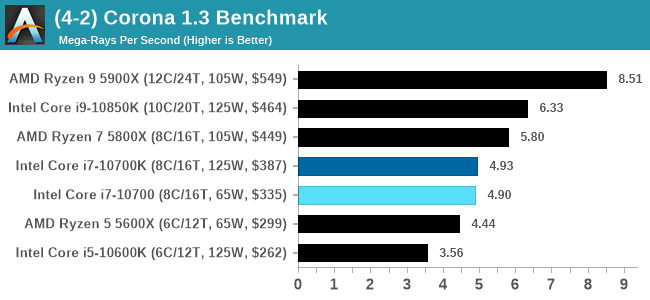
The 10700K takes a small lead.
Crysis CPU-Only Gameplay
One of the most oft used memes in computer gaming is ‘Can It Run Crysis?’. The original 2007 game, built in the Crytek engine by Crytek, was heralded as a computationally complex title for the hardware at the time and several years after, suggesting that a user needed graphics hardware from the future in order to run it. Fast forward over a decade, and the game runs fairly easily on modern GPUs.
But can we also apply the same concept to pure CPU rendering? Can a CPU, on its own, render Crysis? Since 64 core processors entered the market, one can dream. So we built a benchmark to see whether the hardware can.
For this test, we’re running Crysis’ own GPU benchmark, but in CPU render mode. This is a 2000 frame test, with medium and low settings.
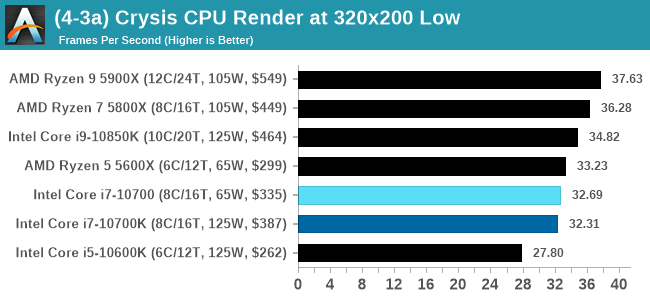
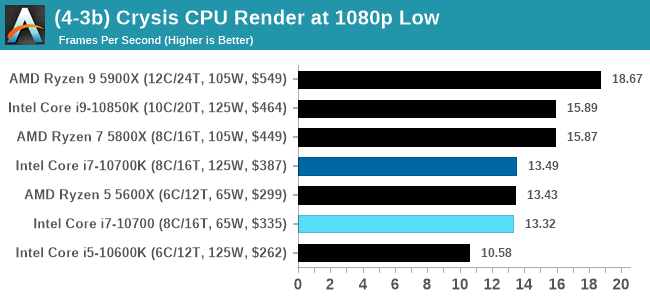
Almost playable.
POV-Ray 3.7.1: Link
A long time benchmark staple, POV-Ray is another rendering program that is well known to load up every single thread in a system, regardless of cache and memory levels. After a long period of POV-Ray 3.7 being the latest official release, when AMD launched Ryzen the POV-Ray codebase suddenly saw a range of activity from both AMD and Intel, knowing that the software (with the built-in benchmark) would be an optimization tool for the hardware.
We had to stick a flag in the sand when it came to selecting the version that was fair to both AMD and Intel, and still relevant to end-users. Version 3.7.1 fixes a significant bug in the early 2017 code that was advised against in both Intel and AMD manuals regarding to write-after-read, leading to a nice performance boost.
The benchmark can take over 20 minutes on a slow system with few cores, or around a minute or two on a fast system, or seconds with a dual high-core count EPYC. Because POV-Ray draws a large amount of power and current, it is important to make sure the cooling is sufficient here and the system stays in its high-power state. Using a motherboard with a poor power-delivery and low airflow could create an issue that won’t be obvious in some CPU positioning if the power limit only causes a 100 MHz drop as it changes P-states.

V-Ray: Link
We have a couple of renderers and ray tracers in our suite already, however V-Ray’s benchmark came through for a requested benchmark enough for us to roll it into our suite. Built by ChaosGroup, V-Ray is a 3D rendering package compatible with a number of popular commercial imaging applications, such as 3ds Max, Maya, Undreal, Cinema 4D, and Blender.
We run the standard standalone benchmark application, but in an automated fashion to pull out the result in the form of kilosamples/second. We run the test six times and take an average of the valid results.
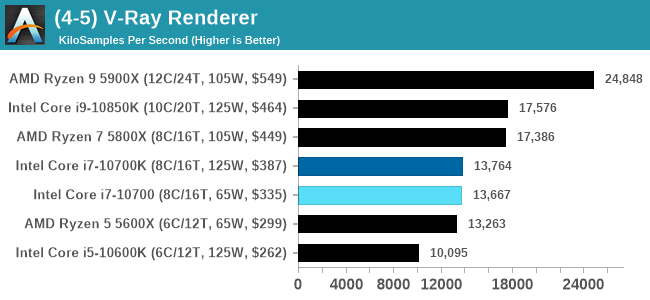
Cinebench R20: Link
Another common stable of a benchmark suite is Cinebench. Based on Cinema4D, Cinebench is a purpose built benchmark machine that renders a scene with both single and multi-threaded options. The scene is identical in both cases. The R20 version means that it targets Cinema 4D R20, a slightly older version of the software which is currently on version R21. Cinebench R20 was launched given that the R15 version had been out a long time, and despite the difference between the benchmark and the latest version of the software on which it is based, Cinebench results are often quoted a lot in marketing materials.
Results for Cinebench R20 are not comparable to R15 or older, because both the scene being used is different, but also the updates in the code bath. The results are output as a score from the software, which is directly proportional to the time taken. Using the benchmark flags for single CPU and multi-CPU workloads, we run the software from the command line which opens the test, runs it, and dumps the result into the console which is redirected to a text file. The test is repeated for a minimum of 10 minutes for both ST and MT, and then the runs averaged.

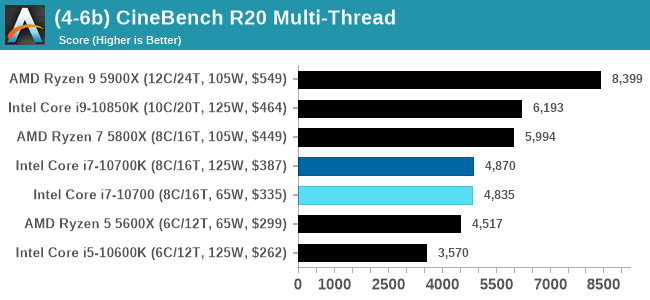
We are still in the process of rolling out CineBench R23 (you can see the results in our benchmark database here), but had not tested it on all the CPUs in this review at this time. It will be added to future reviews.
















210 Comments
View All Comments
Spunjji - Wednesday, January 27, 2021 - link
The review didn't say it is a bad CPU.HarkPtooie - Tuesday, February 2, 2021 - link
Gigabyte B460M DS3HPegged at 100% CPU utilization on 8 cores (HT disabled) the wall meter says 149-163 W, CoreTemp says I use about 70 W core and 8 W uncore. CPU multiplier bounces between 43-47x, though mainly resting at 46x. Temps are 65-66°C using a humble CoolerMaster TX3 Evo.
Just upped the PL1 to 250 W in BIOS. It made no discernible difference, so I suppose it doesn't work on B460 chipsets.
Everett F Sargent - Tuesday, February 2, 2021 - link
Enable HT. If not then why not? The battery of tests conducted here and everywhere else have HT enabled. So far, you are still at the apples != oranges stage. It is now time for you to step up or ... :/Please post results with HT enabled.
Everett F Sargent - Tuesday, February 2, 2021 - link
Oh and the benchmark application that you are using (e. g. Prime95 or whatever) if you do not mind. Please. TIAHarkPtooie - Wednesday, February 3, 2021 - link
So: I set all the PL limits to max (4090 W) and reran. 173 W. Up 10-15 W from default.Then I enabled HT and reran. 213 W. +40 W compared to non-HT.
So I turned off the PL tweaking and reran, with HT on. 204 W initially, then after a while it went down to ca 140 W and the multipliers reduced to about 37x.
Kind of surprised that HT made such a difference, I was under the impression that HT "cores", being a small backpack aside the "real" core, added a tiny percent of transistors overall. I usually disable HT because the software I run don't benefit from them and actually loses performance with it.
So: mystery solved and I stand corrected.
Intel is not lying when they call this a 65 W CPU. They are however obscuring the fact that it does so with REDUCED PERFORMANCE. Its default behavior is to only run at 100% for half a minute.
When allowed by BIOS tweaks, it will double the power draw but run at 100% all the time. This is overclocking in the sense that default settings are overridden - but it is not in the sense that the peak speed is not actually driven above its intended levels. Just maintained at higher power draw.
Aight. I'm back to non-HT and free power. 173W is not that much.
Just did a compare of performance during my simulations, and they were more or less identical to the default settings.
Qasar - Thursday, February 4, 2021 - link
it is possible that the Gigabyte B460M DS3H that you are using ( as per a previous post ) could be holding the cpu back as far as overclocking, power usage and such goes. as the B460m doesnt support overclocking by intel, but asus, asrock and msi seems to have found a way to enable overclocking:https://www.techpowerup.com/266489/asrock-enables-...
https://videocardz.com/newz/asus-asrock-and-msi-br...
at the same time, though, what asus, asrock and msi have done, isnt really overclocking, but more of allowing the cpu to use its turbo states longer, then what intel allows
both of those links, could explain, at least partly, HarkPtooie, why you are getting the results you have.
Everett F Sargent - Thursday, February 4, 2021 - link
Yes, I found those links also. Conspicuously absent from all those reports was Gigabyte. But ...https://www.gigabyte.com/us/Motherboard/Intel-H470...
There you will find ...
B460M DS3H (rev. 1.0)
B460M DS3H AC (rev. 1.x)
B460M DS3H V2 (rev. 1.0)
(ranked oldest to newest afaik)
From the manual for the B460M DS3H (rev. 1.0) (page 25) ...
https://download.gigabyte.com/FileList/Manual/mb_m...
https://download.gigabyte.com/FileList/Manual/mb_m...
https://download.gigabyte.com/FileList/Manual/mb_m...
"Turbo Power Limits
Allows you to set a power limit for CPU Turbo mode. When the CPU power consumption exceeds the specified power limit, the CPU will automatically reduce the core frequency in order to reduce the power. Auto sets the power limit according to the CPU specifications. (Default: Auto)
Package Power Limit TDP (Watts) / Package Power Limit Time
Allows you to set the power limit for CPU Turbo mode and how long it takes to operate at the specified power limit. If the specified value is exceeded, the CPU will automatically reduce the core frequency in order to reduce the power. Auto sets the power limit according to the CPU specifications. This item is configurable only when Turbo Power Limits is set to Enabled. (Default: Auto)
DRAM Power Limit (Watts) / DRAM Power Limit Time
Allows you to set the power limit for memory Turbo mode and how long it takes to operate at the specified power limit. Auto lets the BIOS automatically configure this setting. This item is configurable only when Turbo Power Limits is set to Enabled. (Default: Auto)"
That same language can be found for all three MB manuals. So. it would appear that pl1, pl2 and tau are adjustable as HarkPtooie has suggested (but to be sure the latest bios version should be installed imho).
The only question I have is, why did Gigabyte apparently update the B460M DS3H (rev. 1.0) to the B460M DS3H V2 (rev. 1.0) (maybe they are different in some hardware way that I have failed to notice).
The stress test should be the one that produces the highest temperatures together with the best cooling solution possible for these non-K parts. It sounds a bit circular but then these are non-K parts where we constrain the control knobs to just pl1, pl2 and tau.
Spunjji - Monday, January 25, 2021 - link
"If you are going to make wild speculations whose veracity anyone can check, you might want to go over your material a bit better."The irony of ending your FUD with this... it's glorious!
HarkPtooie - Tuesday, January 26, 2021 - link
It would be ironic if I were wrong, but I sort of trust my eyes here. And my point was that anyone possessing an i7-10700 and a $20 wattmeter can easily check this too.Spunjji - Wednesday, January 27, 2021 - link
Good for you, but I don't trust your eyes - not when every objective review available on the internet contradicts you.